Linearizations of Polynomial Matrices with Symmetries and their Applications PowerPoint PPT Presentation
1 / 26
Title: Linearizations of Polynomial Matrices with Symmetries and their Applications
1
Linearizations of Polynomial Matrices with
Symmetries and their Applications
- E.N. Antoniou, S. Vologiannidis and N.P.
Karampetakis
Aristotle University of Thessaloniki Department
of Mathematics Faculty of Sciences
2
Outline
- Preliminary results
- A new family of companion forms
- Applications to systems described by polynomial
matrices with symmetries - Systems with Symmetric Coefficients
- Systems with Alternating Coefficients
- Conclusions
- Further research
3
Preliminaries
Consider the polynomial matrix
where
The following matrix pencil is known as the 1st
companion matrix of T(s)
4
Preliminaries
The 2nd companion matrix of T(s) is accordingly
defined as
It can be easily seen that
The two companion forms are linearizations of
T(s).
5
A new family of Companion Forms
In ELA04 we have introduced a new family of
linearizations. Define the matrices
where
6
A new family of Companion Forms
Lemma ELA04. The first and second companion
forms of T(s) are given respectively by
Theorem ELA04. Let be the first
companion form of a regular polynomial matrix
. Then for every possible permutation
of the n-tuple the
matrix pencil is strictly equivalent to
7
A new family of Companion Forms
Example. Let
We may choose
or
8
A new family of Companion Forms
Corollary ELA04. Let be the first
companion form of a regular polynomial matrix
. For any four ordered sets of indices
such that
for and
the matrix pencil is
strictly equivalent to where
for and
for
9
A new family of Companion Forms
Example. Let
We may choose
or
10
Applications to systems described by polynomial
matrices with symmetries
Definition. Let det(Tn)?0. Define the following
member of the new family of linearizations as
follows
where
and
The constraint det(Tn)?0 is needed in case where
n is even. However, in that case we can get
Tn10 and we directly go the case where n is odd.
11
Applications to systems described by polynomial
matrices with symmetries
Example. We illustrate the form of Rs(s) for
n4 respectively.
12
Applications to systems described by polynomial
matrices with symmetries
Example. We illustrate the form of Rs(s) for
n4 respectively.
13
Applications to systems described by polynomial
matrices with symmetries
Example. We illustrate the form of Rs(s) for n5
respectively.
14
Systems with Symmetric Coefficients
We consider systems described by differential
equations of the form
with symmetric coefficients, i.e.
Define
the polynomial matrix associated to the above
system.
Question. Is there a linearization of T(s) that
preserves its symmetric structure?
Answer. The proposed linearization has
this appealing property.
15
Systems with Symmetric Coefficients
Example (2nd order system). Consider the second
order mechanical system described by
Where the matrices M,C and K are symmetric. The
associated polynomial matrix is
The proposed symmetric linearization of T(s) is
Obviously, the coefficient matrices of the above
pencil are symmetric too.
16
Systems with Symmetric Coefficients
Example (2nd order system). Consider the second
order mechanical system described by
Where the matrices M,C and K are symmetric. The
associated polynomial matrix is
The proposed symmetric linearization of T(s) is
Obviously, the coefficient matrices of the above
pencil are symmetric too.
17
Systems with Symmetric Coefficients
Example (3rd order system). The numerical
solution of vibration problems by the dynamic
element method requires the solution of the cubic
eigenvalue problem of the form
where
The proposed linearization is
18
Systems with Alternating Coefficients
Let
where the coefficients alternate between
symmetric and skew symmetric.
Definition
- If
- If
where
19
Systems with Alternating Coefficients
Lemma. The matrix pencil L(s) defined above is a
linearization of the polynomial matrix T(s),
having the same alternating property with T(s).
Example (Hamiltonian eigenvalue problems).
Consider the mechanical system governed by the
differential equation
The computation of the optimal control u, that
minimizes the cost functional
20
Systems with Alternating Coefficients
is associated with the eigenvalue problem
The coefficient matrices are from left to right
Hamiltonian, skew Hamiltonian and again
Hamiltonian. After some manipulations the problem
is transformed to the equivalent
where now the coefficient matrices are
respectively symmetric, skew symmetric and again
symmetric
21
Systems with Alternating Coefficients
The proposed linearization of the above
eigenvalue problem now takes the form
22
Systems with Alternating Coefficients
or, by taking a third order systems with zero
highest coefficient matrix, the form
23
Conclusions
- The new family of linearizations has important
applications in - Systems with symmetric coefficients
- Systems with alternating Symmetric skew
Symmetric coefficients - Systems with alternating Hamiltonian skew
Hamiltonian structure - The proposed linearizations preserve the
structure even in the general case (degreegt2) - The computational advantages of the proposed
linearizations are subject of future research
24
2-D Systems with Symmetric Coefficients
Example Consider the 2-D system described by
Where the matrices M and N are symmetric. The
associated polynomial matrix is
The proposed symmetric linearization of T(z1,z2)
is
Obviously, the coefficient matrices of the above
pencil are symmetric too.
25
2-D Systems with Symmetric Coefficients
The proposed symmetric linearization of the above
polynomial matrix in z2 is
Obviously, the coefficient matrices of the above
pencil are symmetric too.
26
Realizations of 2nd order
Example (3rd order system). The numerical
solution of vibration problems by the dynamic
element method requires the solution of the cubic
eigenvalue problem of the form
where
The proposed realization of 2nd order is

